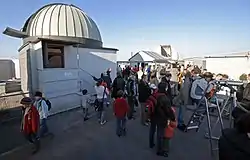< Radiation astronomy 

The observation platform at the Munich Public Observatory provides a splendid view of the city of Munich and the Alps. Credit: Munich Public Observatory.
Astronomy activities is a collection of learning-by-doing resources focused on radiation astronomy and astrophysics.
Astronomy laboratories
Some of these are laboratories that ask the student, teacher, or researcher to conduct an experiment by locating an object of interest on the web or making one up from their imagination.
Astronomy exercises
Others are participatory exercises for particular subjects of interest such as:
- Becoming an observer
- Binary Stars and Extrasolar Planets
- Cassiopeia and Ursa Major
- International Year of Astronomy
- Liquid water on Europa
- Lunar Boom Town
- Lunarpedia
- Observational astronomy
- Stellarium
Astronomy lessons
Lessons are activities that engage the participant in original astronomical research.
Astronomy problems
Problem sets give the participants an opportunity to perform reasoning and mathematics.
Astronomy quizzes
Quizzes allow the students to test their knowledge and test-taking skills.
Theoretical astronomical activities
These are laboratories designed to introduce alternative explanations for astronomical phenomena. Examples include
Entities
Sources
- Backyard Astronomy
- Globulars in M31
- Highest temperature on Jupiter
- Spectral analysis of stars
- Spectrum of Vega
- Standard candles/Laboratory
- Stargazing
- The visible sky
Objects
Hypotheses
- Ancient or prehistorical astronomers watched the skies with more interest than we do today.
See also
- Courses
- Radiation astronomy Department
- Laboratories
- Lectures
- Lessons
- Problems
- Radiation astronomy project
- Quizzes
External links
- International Astronomical Union
- NASA/IPAC Extragalactic Database - NED
- NASA's National Space Science Data Center
- The SAO/NASA Astrophysics Data System
- SDSS Quick Look tool: SkyServer
- SIMBAD Astronomical Database
- SIMBAD Web interface, Harvard alternate
- Spacecraft Query at NASA
- Universal coordinate converter
This article is issued from Wikiversity. The text is licensed under Creative Commons - Attribution - Sharealike. Additional terms may apply for the media files.